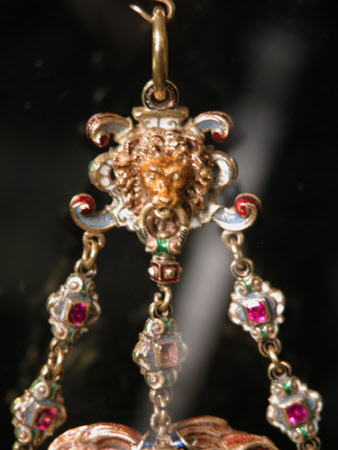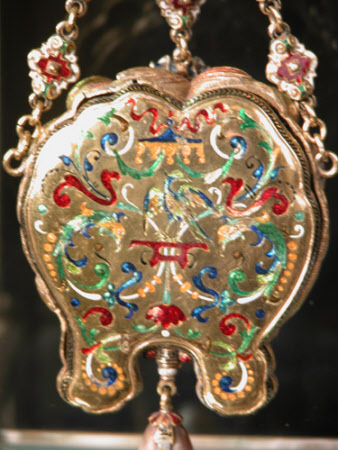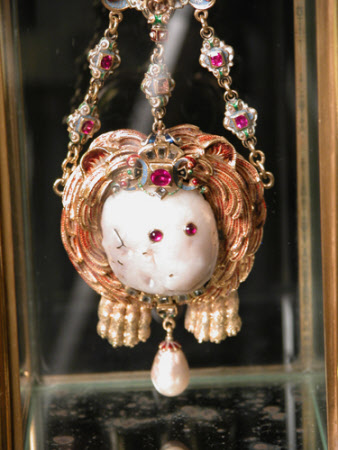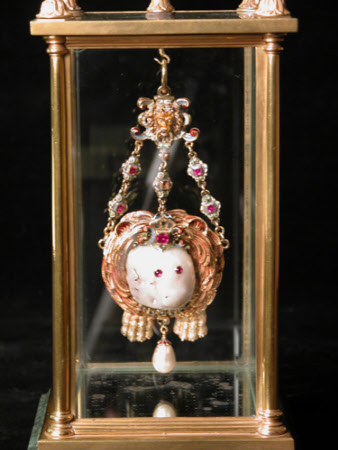Lion's Mask Pendant
possibly Adam Stelter
Category
Objets de vertu
Date
1590 - 1599
Materials
Pearl and gold
Measurements
302 x 134 x 134 mm
Place of origin
Germany
Order this imageCollection
Anglesey Abbey, Cambridgeshire
NT 517290
Caption
Without a solid provenance it is impossible to confirm the history of this object. It is an amazing decorative jewel, a conversation piece for guests during after-dinner drinks.
Summary
Large gold pendant formed as lion's mask with baroque pearl face, set with rubies and diamonds, back enamelled with bird, grotesques and foliage, by Adam Stelter. 3 chains inset with rubies in enamel cartouche chased with lion's mask, enamelled back, pendant pearl at base secures back panel. Glazed gilt metal show case with hook to suspend pendant, on marble base. Connoisseur Magazine 1938 - Fashioned as a locket, the gold front valve is embossed and chased into the likeness of the mane and forepaws of a couchant lion, the head itself being formed by a grotesquely marked baroque pearl of great size in which two rubies have been set for eyes. On the forehead between the golden ears is a small scroll-bordered and gem-set escutcheon. Beneath the ehad are set gems to form a collar from which depends a large pear-shaped pearl. The back valve is an irregularly shaped gold plate with a perched bird with wings spread in translucent enamel, surmounted by an umbrella-like canopy from which depend festoons and ribbons. The remaining space is occupied by arabesques and scrolls in translucent coloured and opaque white enamel. Above are three short gold, enamelled and gem-set chains converging to and uniting beneath a scroll-bordered escutcheon bearing on the front a small lion's mask in high relief. Of south German origin and of the close of 16th-century. The elaborate enamel-work suggests the work of Corvinianus Saur, Court goldsmith to King Christian IV of Denmark,Member of the Guild of Goldsmiths. In 1606 Saur was invited to the Danish Court and became Court goldsmith in 1613 until his death in 1635. Believed to be of Bavarian origin, and a representation of the Lion of the House of Wittelsbach. Despite its size it is a woman's ornament, and its approximate date of the 1590's limits its ownership to either Elizabeth Renata (b.1574) daughter of Charles II of Lorraine, who in 1595 married Duke Maximilian I, subsequently Elector of Bavaria, or Louise Juliana, daughter of William I of Orange-Nassau (William the Silent, the Lion of the Netherlands), who in 1593 married the Elector Palatine Frederick IV. Although the former is more probable, the latter would be a suitable gift from the Lion of the Palatine to the daughter of the Lion of the Netherlands.
Provenance
Bequeathed to the National Trust by Huttleston Rogers Broughton, 1st Lord Fairhaven (1896-1966) with the house and the rest of the contents Connoisseur Magazine 1938 - The recent history of this jewel is unrecorded. It has made no appearance in any sale of recent years, but it is known to have been in England for a very considerable period. Attached to it, however, is the name Farquhar - possibly Joh Farquhar, the millionaire, who in 1823 purchased Fonthill Abbey and its treasures from William Beckford. Beckford, on the evidence of the catalogue prepared by James Christie for the sale on Sept 17th 1822, is known to have possessed a number of relics of the House of Wittelsbach.
Makers and roles
possibly Adam Stelter, goldsmith Adam Stelter, jeweller





